The Design, Simulation, and Construction of an O2, C3H8, and CO2 Gas Detection System Based on the Electrical Response of MgSb2O6 Oxide
Abstract
1. Introduction
2. Methodology and Experiments
2.1. Synthesis
2.2. Physical Characterization
2.3. Gas Measurement Tests
3. Results
3.1. XRD Analysis
3.2. SEM Analysis
3.3. Gas Sensing Property Analysis
3.4. Sensor Resistance
3.5. Sensor Signal Adaptation and Resolution
3.6. Output Signals: Correction and Indicators
3.7. System Configuration
3.8. Power Source
3.9. Programming Considerations
3.10. Electronic Diagram
3.11. Simulation
3.12. Assembling the Device
4. Discussion
- The gas detector operates in high concentrations (560 ppm) and high temperatures (400 °C). This detector is ideal for industrial applications.
- The detector can be configured to detect one, two, or three gases: , , and . The configuration is performed through switch buttons.
- The detector is protected against electrical dischargers through relays, while the PIC18F4550 microcontroller is electrically protected by optocouplers.
- The response time is 3 s, but this time can be modified through the electrical response of the sensor.
- Due to it being an electronic programmable system, the detector can be escalated for the Internet of Things or adapted to industrial networks.
- The detector possesses corrective signals for each detected gas. Additionally, it lights indicator diodes when the device detects the presence of gas in the monitoring environment.
- The prototype is low-cost, easy to repair, easy to maneuvere, and its size can be optimized by employing electronic components of smaller sizes.
- The sensors must be placed in different points of detection.
5. Conclusions
Author Contributions
Funding
Institutional Review Board Statement
Informed Consent Statement
Data Availability Statement
Acknowledgments
Conflicts of Interest
References
- Prokopiuk, A.; Wojtas, J. Accelerating the Diagnosis of Pandemic Infection Based on Rapid Sampling Algorithm for Fast-Response Breath Gas Analyzers. Sensors 2024, 24, 6164. [Google Scholar] [CrossRef] [PubMed]
- Bergmann, S.; Li, B.; Pilot, E.; Chen, R.; Wang, B.; Yang, J. Effect modification of the short-term effects of air pollution on morbidity by season: A systematic review and meta-analysis. Sci. Total Environ. 2020, 716, 136985. [Google Scholar] [CrossRef] [PubMed]
- Manisalidis, I.; Stavropoulou, E.; Stavropoulos, A.; Bezirtzoglou, E. Environmental and Health Impacts of Air Pollution: A Review. Front. Public Health 2020, 8, 14. [Google Scholar] [CrossRef] [PubMed]
- Meng, F.J.; Xin, R.F.; Li, S.X. Metal Oxide Heterostructures for Improving Gas Sensing Properties: A Review. Materials 2023, 16, 263. [Google Scholar] [CrossRef]
- Li, G.; Zhu, X.; Liu, J.; Li, S.; Liu, X. Metal Oxide Semiconductor Gas Sensors for Lung Cancer Diagnosis. Chemosensors 2023, 11, 251. [Google Scholar] [CrossRef]
- Casanova-Chafer, J.; Garcia-Aboal, R.; Atienzar, P.; Bittencourt, C.; Llobet, E. Perovskite@Graphene Nanohybrids for Breath Analysis: A Proof-of-Concept. Chemosensors 2021, 9, 215. [Google Scholar] [CrossRef]
- Azmoodeh, Z.; Moghaddam, H.M.; Nasirian, S. Hydrogen gas sensing feature of polypyrrole nanofibers assisted by spinel ZnMn2O4 microspheres in dynamic conditions. Int. J. Hydrogen Energy 2022, 47, 29971–29984. [Google Scholar] [CrossRef]
- Singh, S.; Singh, A.; Singh, A.; Tandon, P. A stable and highly sensitive room-temperature liquefied petroleum gas sensor based on nanocubes/cuboids of zinc antimonate. RSC Adv. 2020, 10, 20349–20357. [Google Scholar] [CrossRef] [PubMed]
- Singh, A.; Singh, A.; Singh, S.; Tandon, P. Nickel antimony oxide (NiSb2O6): A fascinating nanostructured material for gas sensing application. Chem. Phys. Lett. 2016, 646, 41–46. [Google Scholar] [CrossRef]
- Zhang, L.; Li, F.; Yang, Y.; Li, D.; Yu, H.; Dong, X. Polyoxometalates/Metal-organic frameworks-derived ZnO/ZnWO4 nanoparticles for highly sensitive selective ppb-level NO2 detection. Chem. Eng. J. 2024, 499, 156604. [Google Scholar] [CrossRef]
- Li, P.; Yang, Y.; Li, F.; Pei, W.; Li, D.; Yu, H.; Dong, X.; Wang, D. Effect of Polyoxometalates electron acceptor decoration on NO2 sensing behavior of ZnS microspheres toward rapid and ultrahigh response. Sens. Actuators B Chem. 2025, 425, 137111. [Google Scholar] [CrossRef]
- Zhang, L.; Wang, T.; Yang, Y.; Wei, M.; Li, F.; Yu, H.; Dong, X. In situ synthesis of polyoxometalate-derved MoS2/phosphomolybdic acid composites for highly sensitive NO2 detection. J. Alloys Compd. 2024, 977, 173430. [Google Scholar] [CrossRef]
- Zhang, L.; Tian, J.; Wang, Y.; Wang, T.; Wei, M.; Li, F.; Li, Y.; Yang, Y.; Yu, H.; Dong, X. Polyoxometelates electron acceptor-intercalated In2O3@SnO2 nanofibers for chemiresistive ethanol gas sensors. Sens. Actuators B Chem. 2024, 410, 135728. [Google Scholar] [CrossRef]
- Zhang, M.; Yang, Y.; Li, D.; Yu, H.; Dong, X.; Wang, T. First Polyoxometalate-modified SnS2 composite nanostructurate gas sensor toward enhanced sensitivity and high selectivity NO2 detection. Sens. Actuators B Chem. 2024, 409, 135641. [Google Scholar] [CrossRef]
- Song, P.; Wang, T. Application of polyoxometelates in chemiresistive gas sensors: A. Review. ACS Sens. 2022, 7, 3634–3643. [Google Scholar] [CrossRef]
- Matvei, A.; Maxim, T.; Asachenko, A.; Beltiukov, A.; Amelichev, V.; Sagitova, A.; Maksimov, S.; Smirnov, A.; Rumyantseva, M.; Krivetskiy, V. Electrical and Gas Sensor Properties of Nb(V) Doped Nanocrystalline β-Ga2O3. Materials 2022, 15, 8916. [Google Scholar] [CrossRef] [PubMed]
- Singh, S.; Singh, A.; Singh, A.; Rathore, S.; Yadav, B.C.; Tandon, P. Nanostructured cobalt antimonate: A fast responsive and highly stable sensing material for liquefied petroleum gas detection at room temperature. RSC Adv. 2020, 10, 33770–33781. [Google Scholar] [CrossRef] [PubMed]
- Ramírez-Ortega, J.A.; Guillén-Bonilla, H.; Guillén-Bonilla, A.; Rodríguez-Betancourtt, V.M.; Sánchez-Martínez, A.; Guillén-Bonilla, J.T.; Gildo-Ortiz, L.; Huízar-Padilla, E.; Reyes-Gómez, J. Synthesis of the oxide NiSb2O6 and its electrical characterization in toxic atmospheres for its application as a gas sensor. J. Mater. Sci. Mater. Electron. 2022, 33, 18268–18283. [Google Scholar] [CrossRef]
- Ramírez-Ortega, J.A.; Guillén-Bonilla, J.T.; Guillén-Bonilla, A.; Rodríguez-Betancourtt, V.M.; Gildo-Ortiz, L.; Blanco-Alonso, O.; Soto-García, V.M.; Jiménez-Rodríguez, M.; Guillén-Bonilla, H. Preparation of Powders Containing Sb, Ni, and O for the Design of a Novel CO and C3H8 Sensor. Appl. Sci. 2021, 11, 9536. [Google Scholar] [CrossRef]
- Guillen Bonilla, J.T.; Guillen Bonilla, A.; Casillas Zamora, A.; Guillen Bonilla, H. Zinc aluminate (ZnAl2O4) applied in the development of a propane gas sensor and in the design of a digital gas detector. J. Mater. Sci. Mater. Electron. 2023, 34, 967. [Google Scholar] [CrossRef]
- Quintana Barcia, P.J.; García, J. Signal conditioning I: Adaptation and protection stages. In Encyclopedia of Electrical and Electronic Power Engineering; Elsevier: Oxford, UK, 2023; pp. 46–56. [Google Scholar] [CrossRef]
- Dobkin, B.; Hamburger, J. Analog Circuit Desing; Elsevier Science: Amsterdam, The Netherlands, 2014; Volume 3. [Google Scholar]
- Li, Z.; Brackmann, C.; Bood, J.; Richter, M.; Bengtsson, P.E.; Kohse Hoinghaus, K. Laser diagnostics in combustion and beyond dedicated to Prof. Marcus Alden on his 70th birthday. Combust. Flame 2024, 263, 113403. [Google Scholar] [CrossRef]
- Moroshkina, A.; Sereshchenko, E.; Mislavskii, V.; Gubernov, V.; Minaev, S. Study of chemiluminescence f methane-air, flame stabilized on flat porous burner. Combust. Flame 2024, 270, 113755. [Google Scholar] [CrossRef]
- Proakis, J.G.; Manolakis, D.G. Digital Signal Processing, Principles, Algorithms and Applications, 4th ed.; Prentice-Hall International: Hoboken, NJ, USA, 2017. [Google Scholar]
- Stergiopoulos, S. Advances Signal Processing, 2nd ed.; CRC Press: Boca Raton, FL, USA, 2017. [Google Scholar] [CrossRef]
- Hiroshi, M.; Woodward, P.M. Electronic Structure Studies of Main Group Oxides Possessing Edge-Sharing Octahedra: Implications for the Design of Transparent Conducting Oxides. Chem. Mater. 2004, 16, 5233–5248. [Google Scholar]
- Larcher, D.; Prakash, A.S.; Laffont, L.; Womes, M.; Jumas, J.C.; Olivier-Fourcade, J.; Hedge, M.S.; Tarascon, J.M. Reactivity of antimony oxides and MSb2O6 (M=Cu, Ni, Co), Ttrirutile-type phases with metallic lithium. J. Electrochem. Soc. 2006, 153, A1778–A1787. [Google Scholar] [CrossRef]
- Michel, C.R.; Martínez, A.H.; Jiménez, S. Gas sensing response of nanostructured trirutile-type CoSb2O6 synthesized by solution-polymerization method. Sens. Actuators B Chem. 2008, 132, 45–51. [Google Scholar] [CrossRef]
- Juárez-Amador, L.I.; Guillén-Bonilla, H.; Guillén-Bonilla, A.; Guillén-Bonilla, J.T.; Morales-Bautista, J.; Casillas-Zamora, A.; Rodríguez-Betancourtt, V.-M.; Olvera-Amador, M.d.l.L. Photocatalytic and sensing properties in propane atmospheres of MgSb2O6 nanoparticles synthesized by a chemical method. J. Mater. Sci. Mater. Electron. 2024, 35, 1857. [Google Scholar] [CrossRef]
- Nikulin, A.Y.; Zvereva, E.A.; Nalbandyan, V.B.; Shukaev, I.L.; Kurbakov, A.I.; Kuchugura, M.D.; Raganyan, G.V.; Popov, Y.V.; Ivanchenko, V.D.; Vasiliev, A.N. Preparation and characterization of metastable trigonal layered MSb2O6 phases (M = Co, Ni, Cu, Zn, and Mg) and considerations on FeSb2O6. Dalton Trans. 2017, 46, 6059–6068. [Google Scholar] [CrossRef] [PubMed]
- Arunkumar, N.; Saraschandra, N. Facile synthesis of N-MgSb2O6 trirutile antimonate and its enhanced photocatalytic performance. Int. J. Environ. Anal. Chem. 2022, 102, 7938–7952. [Google Scholar]
- Guillén-Bonilla, H.; Guillén-Bonilla, J.T.; Rodríguez-Betancourtt, V.M.; Ramírez-Ortega, J.A.; Morán Lázaro, J.P.; Guillén-Bonilla, A. Synthesis and Sensing Response of Magnesium Antimoniate Oxide (MgSb2O6) in the Presence of Propane Atmospheres at Different Operating Voltages. Sensors 2024, 24, 2147. [Google Scholar] [CrossRef]
- Gildo-Ortiz, L.; Rodríguez-Betancourtt, V.-M.; Ramírez Ortega, J.A.; Blanco-Alonso, O. An Alternative Approach for the Synthesis of Zinc Aluminate Nanoparticles for CO and Propane Sensing Applications. Chemosensors 2023, 11, 105. [Google Scholar] [CrossRef]
- Matijevic, E. Uniform inorganic colloid dispersions. achievements and challenges. Langmuir 1994, 10, 8–16. [Google Scholar] [CrossRef]
- Michel, C.R.; Martínez-Preciado, A.H.; Morán-Lázaro, J.P. Effect of the frequency on the gas sensing response of CoSb2O6 prepared by a colloidal method. Sens. Actuators B Chem. 2009, 140, 149–154. [Google Scholar] [CrossRef]
- Gorbunov, V.V.; Shidlovskii, A.A.; Shmagin, L.F. Combustion of transition-metal ethylenediamine nitrates. Combust. Explos. Shock. 1983, 19, 172–173. [Google Scholar] [CrossRef]
- Tereshkov, M.; Dontsova, T.; Saruhan, B.; Krüger, S. Metal Oxide-Based Sensors for Ecological Monitoring: Progress and Perspectives. Chemosensors 2024, 12, 42. [Google Scholar] [CrossRef]
- Nadargi, D.Y.; Umar, A.; Nadargi, J.D.; Lokare, S.A.; Akbar, S.; Mulla, I.S.; Suryavanshi, S.S.; Bhandari, N.L.; Chaskar, M.G. Gas sensors and factors influencing sensing mechanism with a special focus on MOS sensors. J. Mater. Sci. 2023, 58, 559–582. [Google Scholar] [CrossRef]
- Michel, C.R.; Lopez Contreras, N.L.; Lopez-Alvarez, M.A.; Martinez-Preciado, A.H. Gas selectivity of nanostructured ZnSb2O6 synthesized by a colloidal method. Sens. Actuators B Chem. 2012, 171–172, 686–690. [Google Scholar] [CrossRef]
- Arshak, K.; Moore, E.; Lyons, G.M.; Harris, J.; Clifford, S. A review of gas sensors employed in electronic nose applications. Sens. Rev. 2004, 24, 181–198. [Google Scholar] [CrossRef]
- Marikutsa, A.; Rumyantseva, M.; Konstantinova, E.A.; Gaskov, A. The Key Role of Active Sites in the Development of Selective Metal Oxide Sensor Materials. Sensors 2021, 21, 2554. [Google Scholar] [CrossRef]
- Engelkamp, B.; Schierbaum, K. Oxygen Sensing of Pt/PEO-TiO2 in Humid Atmospheres at Moderate Temperatures. Sensors 2021, 21, 2558. [Google Scholar] [CrossRef]
- Bharati, K.; Tiwari, P.R.; Singh, R.P.; Singh, A.; Yadav, B.C.; Singh, M.P.; Kumar, S. Synthesis of bismuth-doped praseodymium ortho ferrite nanomaterials for LPG sensing. Appl. Nanosci. 2024, 14, 277–289. [Google Scholar] [CrossRef]
- Aishwarya, K.; Nirmala, R.; Navamathavan, R. Recent advancements in liquefied petroleum gas sensors: A topical review. Sens. Int. 2021, 2, 100091. [Google Scholar] [CrossRef]
- Kumar-Jayaraman, V.; Maldonado-Álvarez, A.; Olvera-Amador, M.L. A simple and cost-effective zinc oxide thin film sensor for propane gas detection. Mater. Lett. 2015, 157, 169–171. [Google Scholar] [CrossRef]
- Meena, D.; Jain, M.; Bhatnagar, M.C. Resistive gas sensors based on nanostructured ternary metal oxide: A review. J. Mater. Sci. 2024, 59, 12177–12218. [Google Scholar] [CrossRef]
- Dey, A. Semiconductor metal oxide gas sensors: A review. Mater. Sci. Eng. B 2018, 229, 206–217. [Google Scholar] [CrossRef]
- Tsuji, H.; Okamura-Yoshida, A.; Shishido, T.; Hattori, H. Dynamic behavior of carbonate species on metal oxide surfaces: Oxygen scrambling between adsorbed carbon dioxide and oxide surface. Langmuir 2003, 19, 8793–8800. [Google Scholar] [CrossRef]
- Chackrabarti, S.; Zargar, R.A.; Mearaj, T.; Hafiz, A.K. CO2 sensing properties of semiconducting copper oxide and spinel ferrite nanocomposite thin film. Appl. Surf. Sci. 2010, 256, 4715–4719. [Google Scholar]
- Chang, S.C. Oxygen chemisorption on tin oxide: Correlation between electrical conductivity and EPR measurements. J. Vac.Sci. Technol. 1979, 17, 366–369. [Google Scholar] [CrossRef]
- Bläser, G.; Rühl, T.; Diehl, C.; Ulrich, M.; Kohl, D. Nanostructured semiconductor gas sensors to overcome sensitivity limitations due to percolation effects. Phys. A: Stat. Mech. Its Appl. 1999, 266, 218–223. [Google Scholar] [CrossRef]
- Degler, D. Trends and Advances in the Characterization of Gas Sensing Materials Based on Semiconducting Oxides. Sensors 2018, 18, 3544. [Google Scholar] [CrossRef]
- Guillén-Bonilla, H.; Rodríguez-Betancourtt, V.-M.; Guillen-Bonilla, J.T.; Gildo-Ortiz, L.; Guillen-Bonilla, A.; Casallas-Moreno, Y.L.; Blanco-Alonso, O.; Reyes-Gómez, J. Sensitivity Tests of Pellets Made from Manganese Antimonate Nanoparticles in Carbon Monoxide and Propane Atmospheres. Sensors 2018, 18, 2299. [Google Scholar] [CrossRef] [PubMed]
- Gómez-Pozos, H.; González-Vidal, J.L.; Torres, G.A.; Olvera, M.D.l.L.; Castañeda, L. Physical Characterization and Effect of Effective Surface Area on the Sensing Properties of Tin Dioxide Thin Solid Films in a Propane Atmosphere. Sensors 2014, 14, 403–415. [Google Scholar] [CrossRef]
- Zabczyk, J. Mathematical Control Theory, 2nd ed.; BirkhÖuser: Basel, Switzerland, 2020. [Google Scholar]
- Zvonkova, M.; Adamek, M.; Skowronkova, N.; Dlabaja, S.; Matyas, J.; Jasso, M.; Adamkova, A.; Mlcek, J.; Nikolaos Salek, R.; Buran, M. Compact 3D-Printed Unit for Separation of Simple Gas Mixtures Combined with Chemiresistive Sensors. Sensors 2024, 24, 4391. [Google Scholar] [CrossRef]
- Scheuer, K.G.; DeCorby, R.G. All-Optical, Air-Coupled Ultrasonic Detection of Low-Pressure Gas Leaks and Observation of Jet Tones in the MHz Range. Sensors 2023, 23, 5665. [Google Scholar] [CrossRef] [PubMed]
- Cao, S.; Jiao, Y.; Xiao, G.; Wu, W.; Xie, Z.; Li, J.; Liu, X.; Zhao, E.; Yue, Z. Miniaturized photoelectrochemical sensing system for reusable detection of macromolecules and its applications for unattended environmental monitoring. Sens. Actuators B Chem. 2024, 421, 136515. [Google Scholar] [CrossRef]
- Guillén Bonilla, H.; Guillén Bonilla, J.T.; Rodríguez Betancourtt, V.M.; Jiménez-Rodríguez, M.; Guillén-Bonilla, A.; Huízar-Padilla, E.; Sánchez-Morales, M.E.; Ramirez-Ortega, J.A.; Blanco-Alonso, O. Electrical Response of the Spinel ZnAl2O4 and Its Application in the Detection of Propane Gas. Appl. Sci. 2021, 11, 9488. [Google Scholar] [CrossRef]
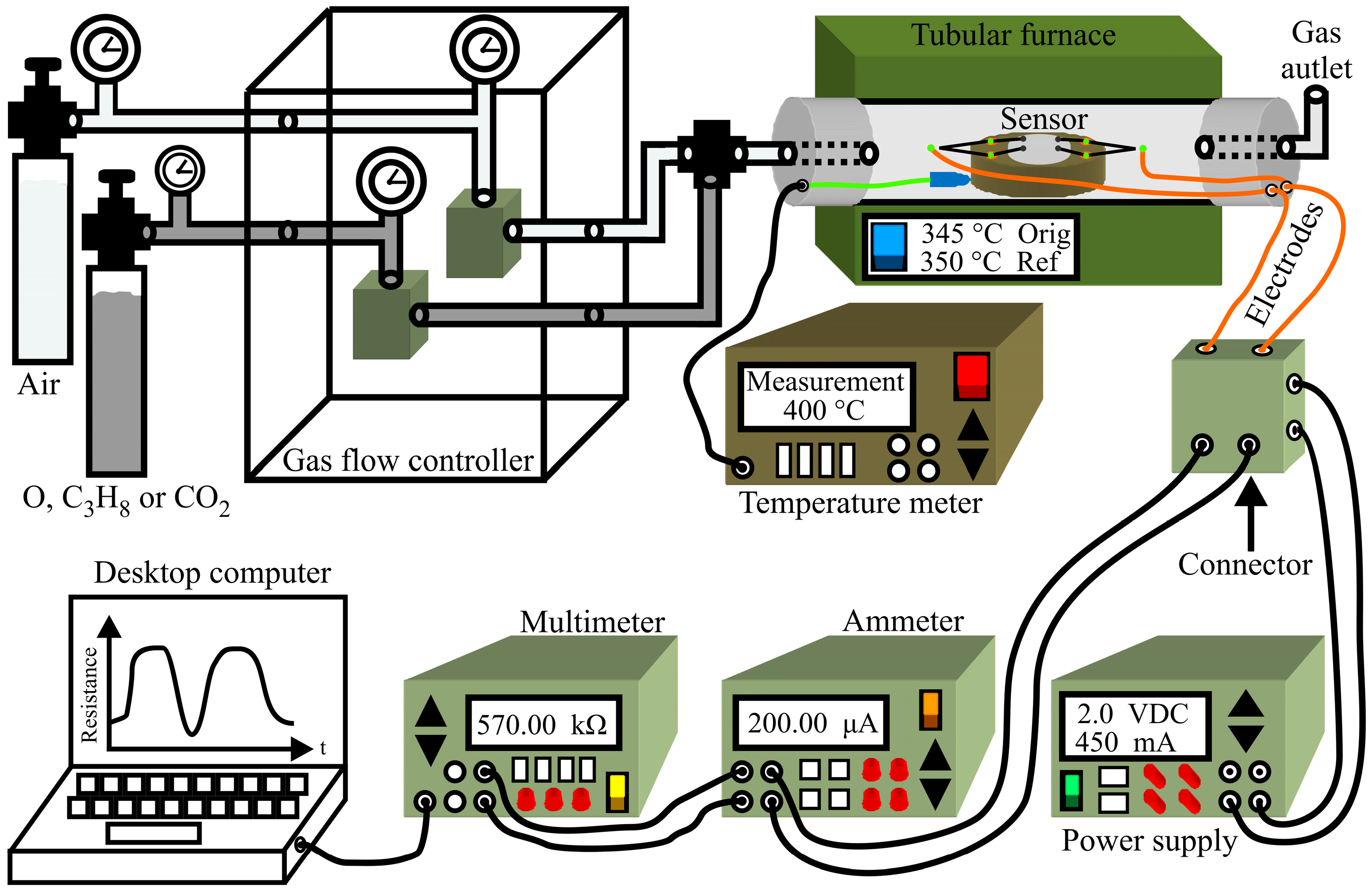
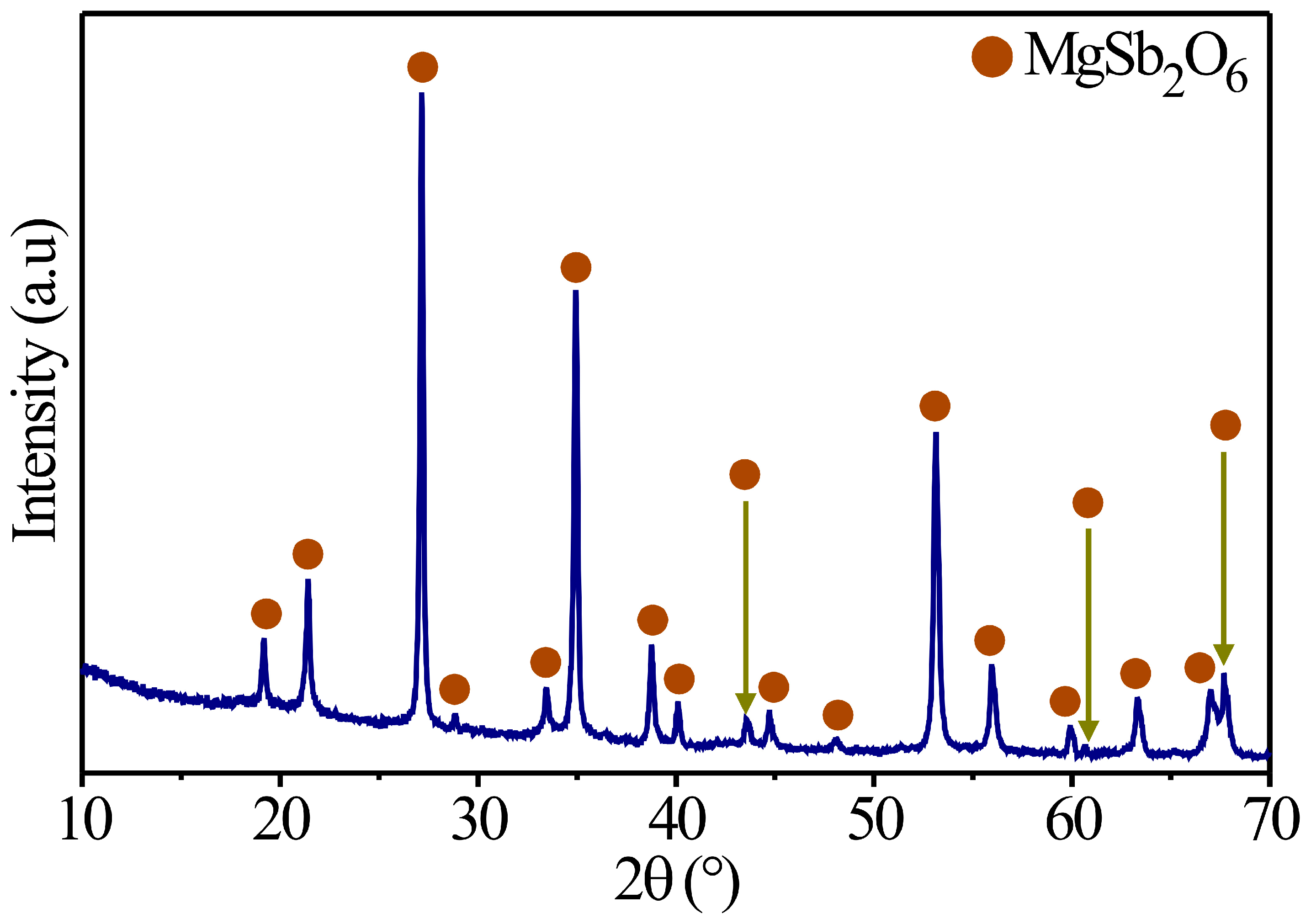



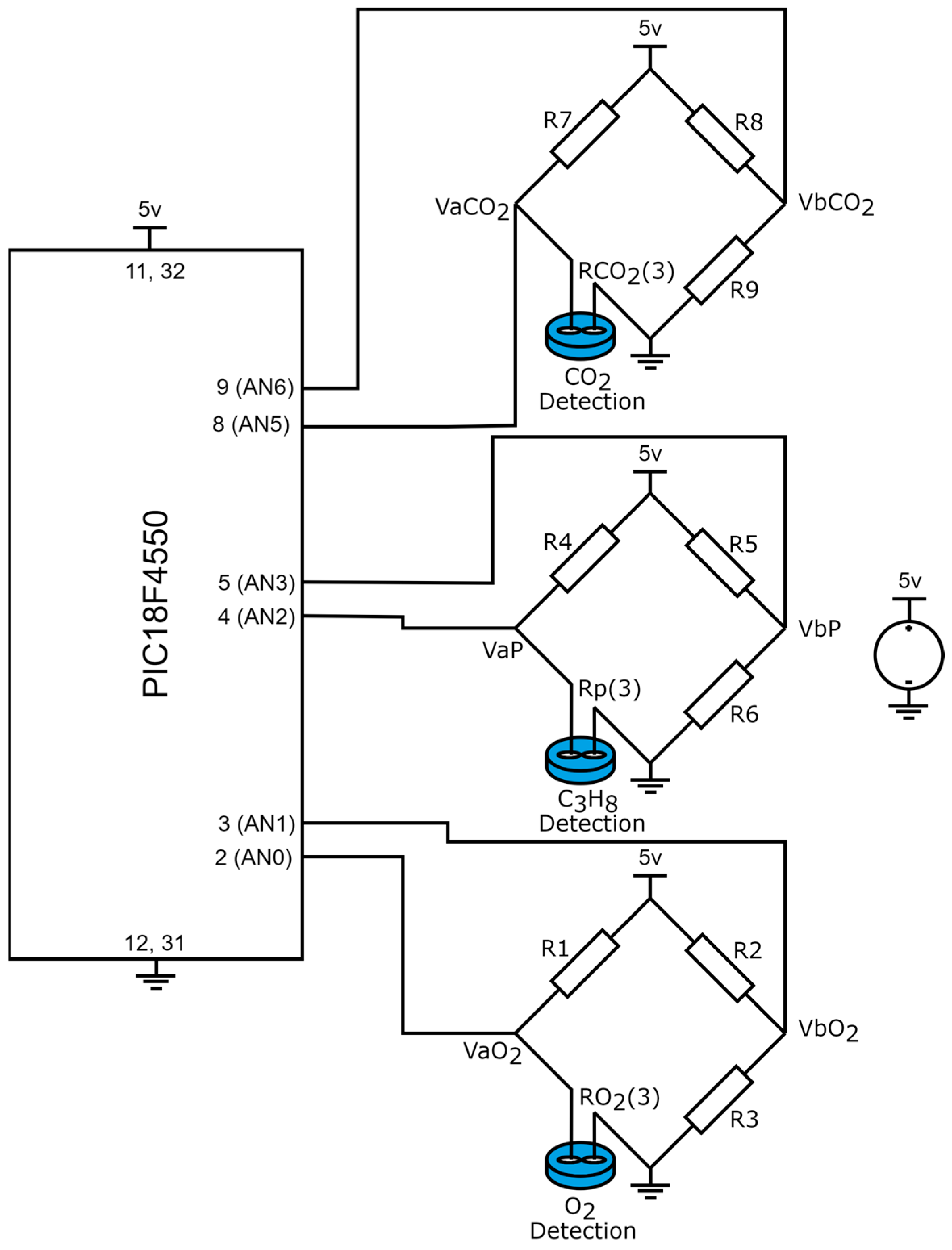
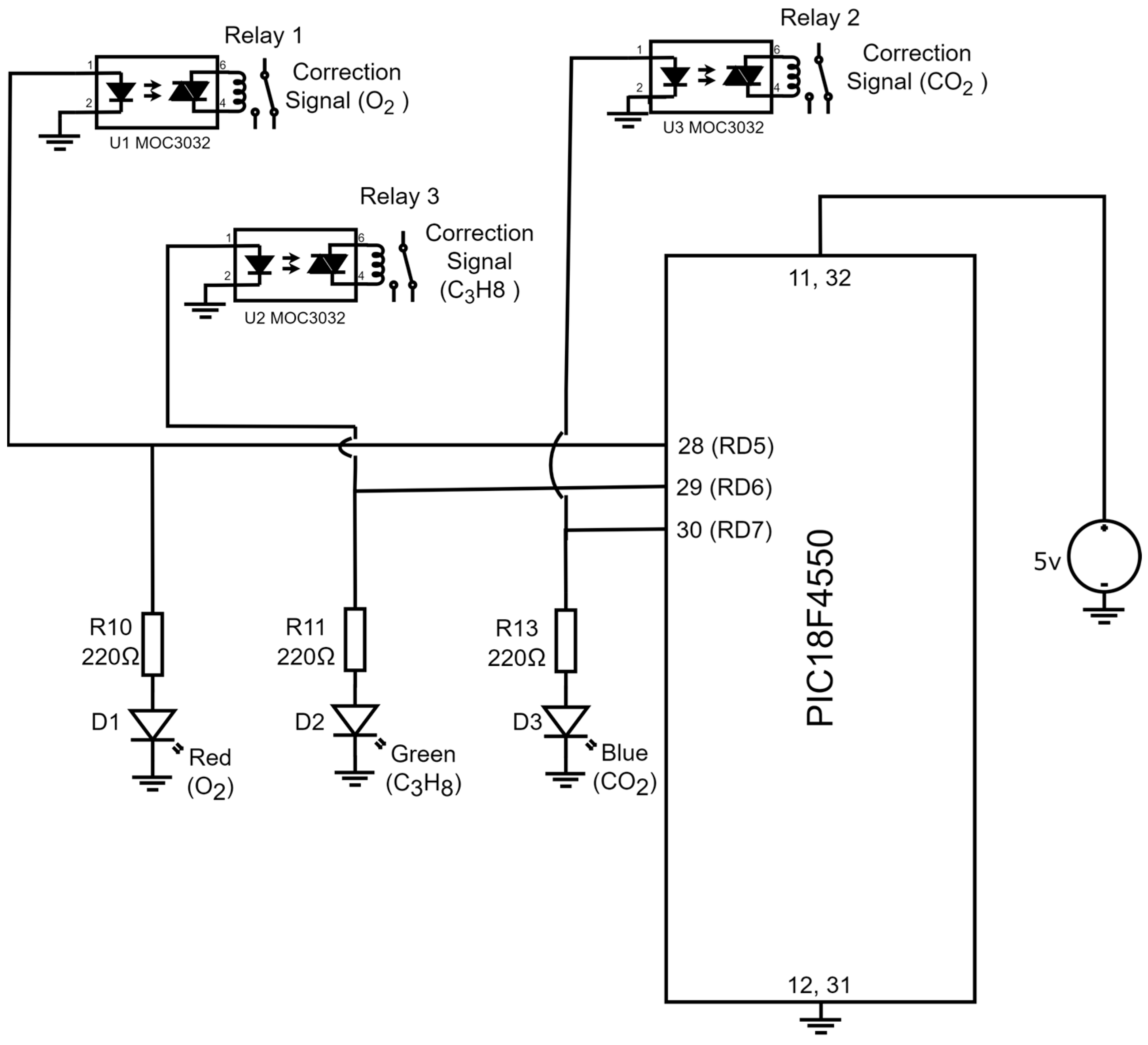
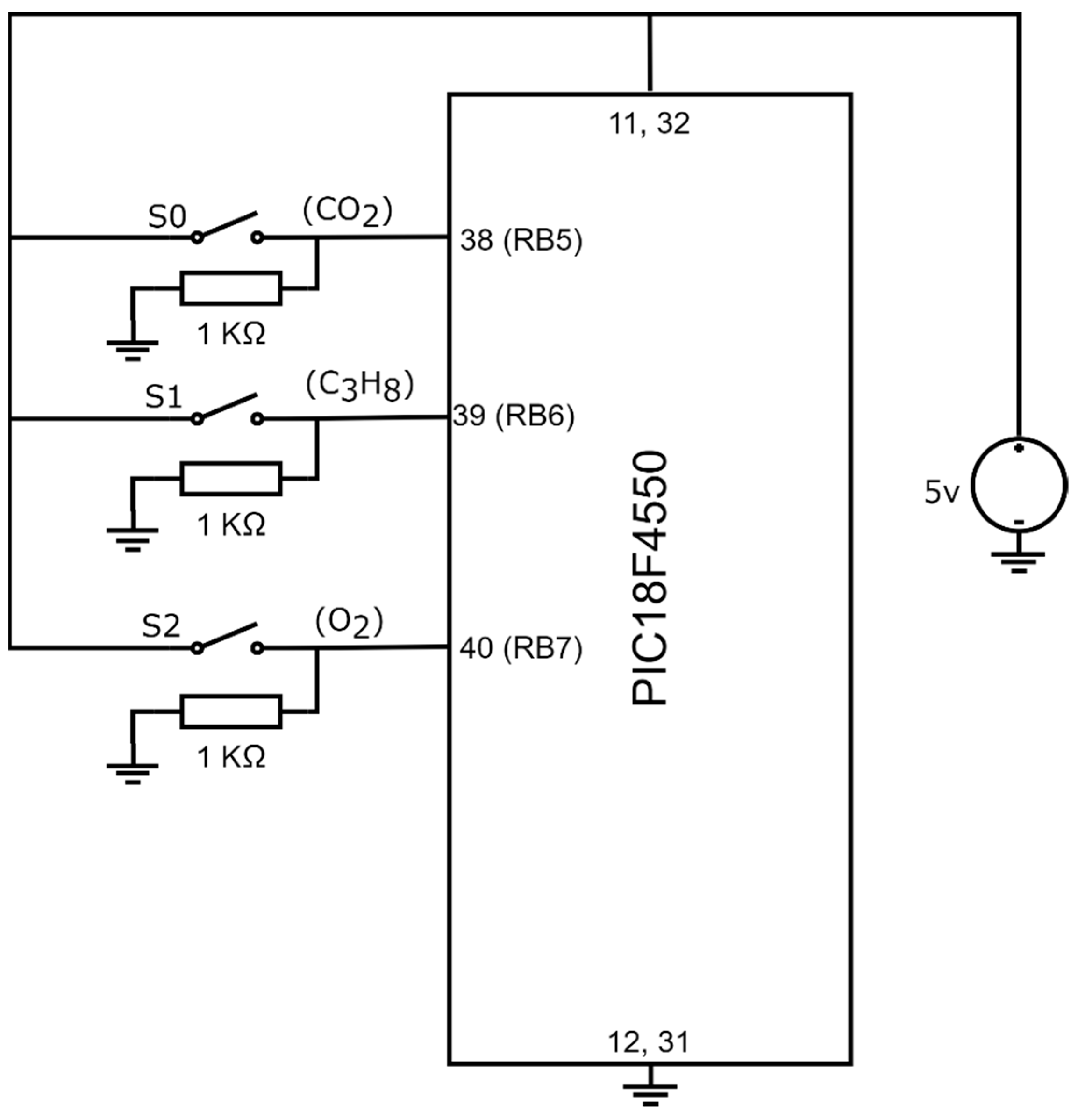

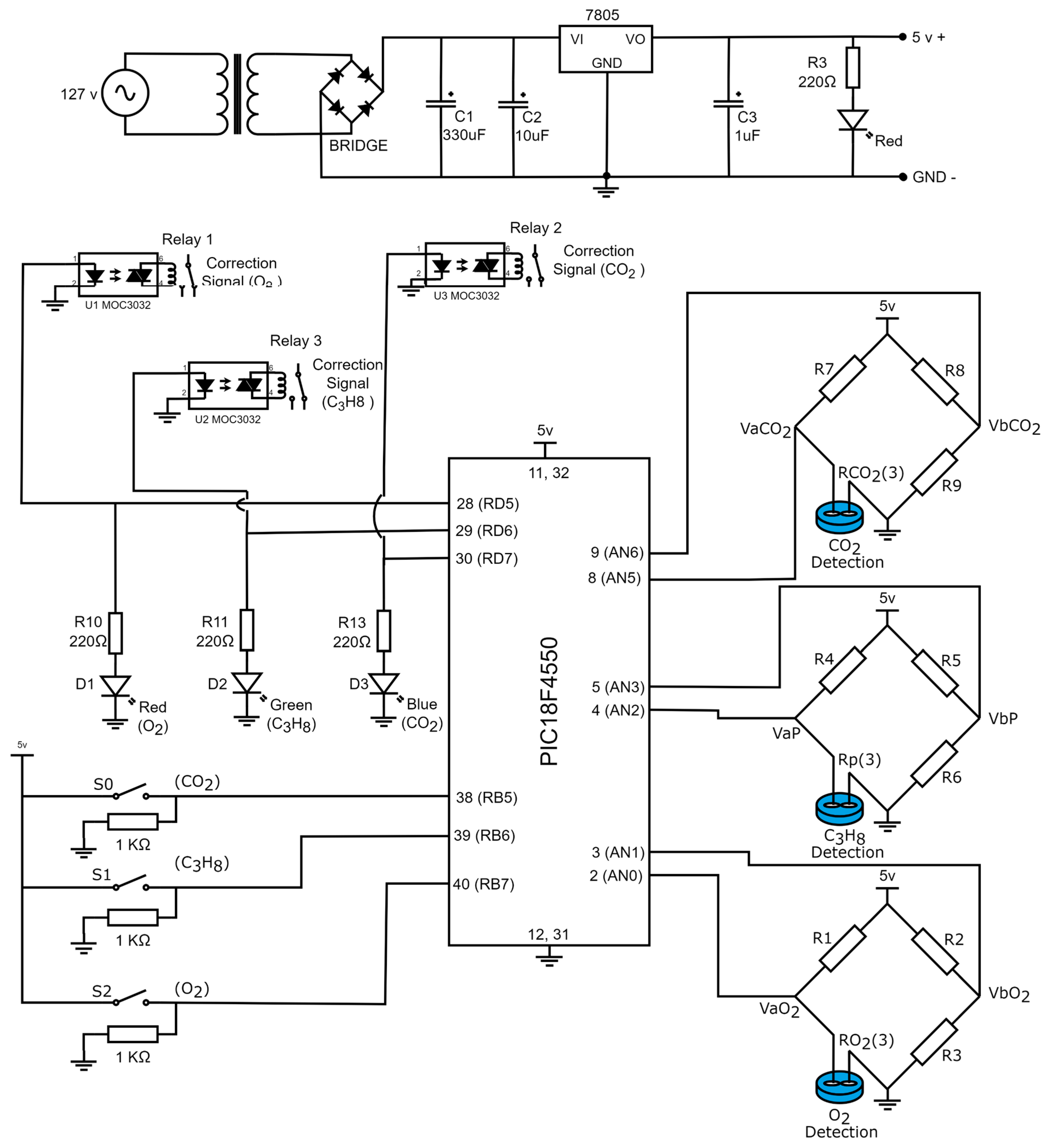
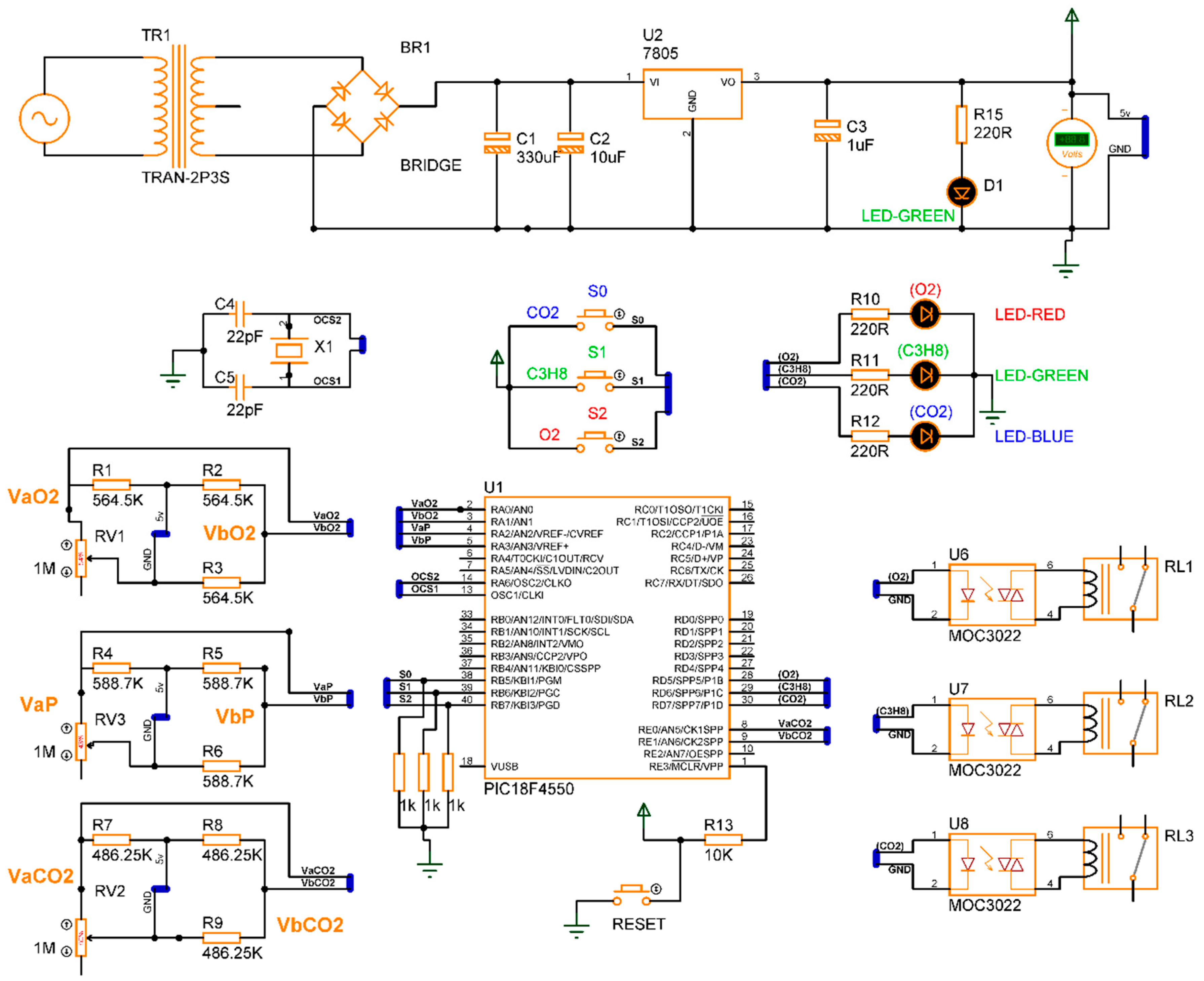

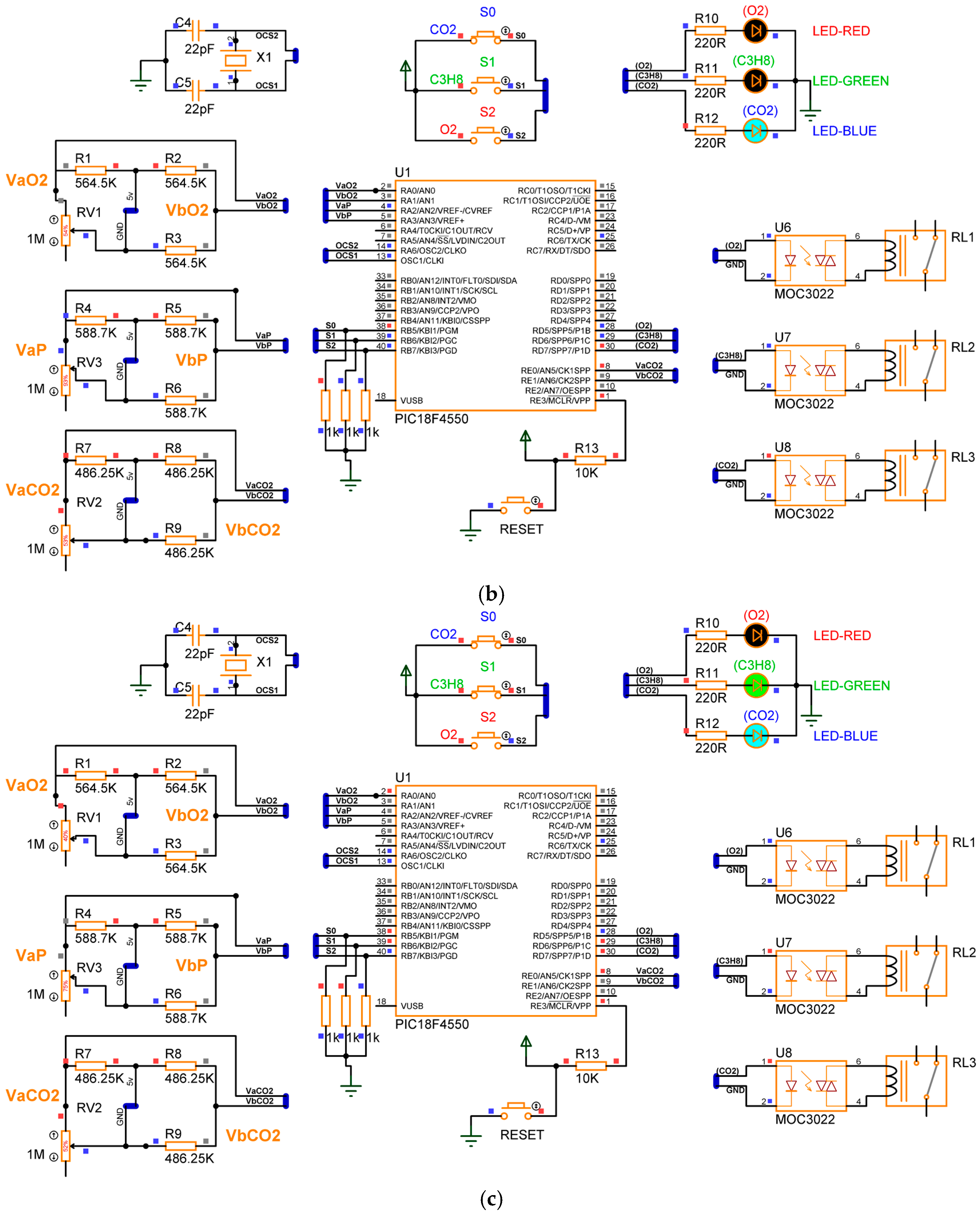
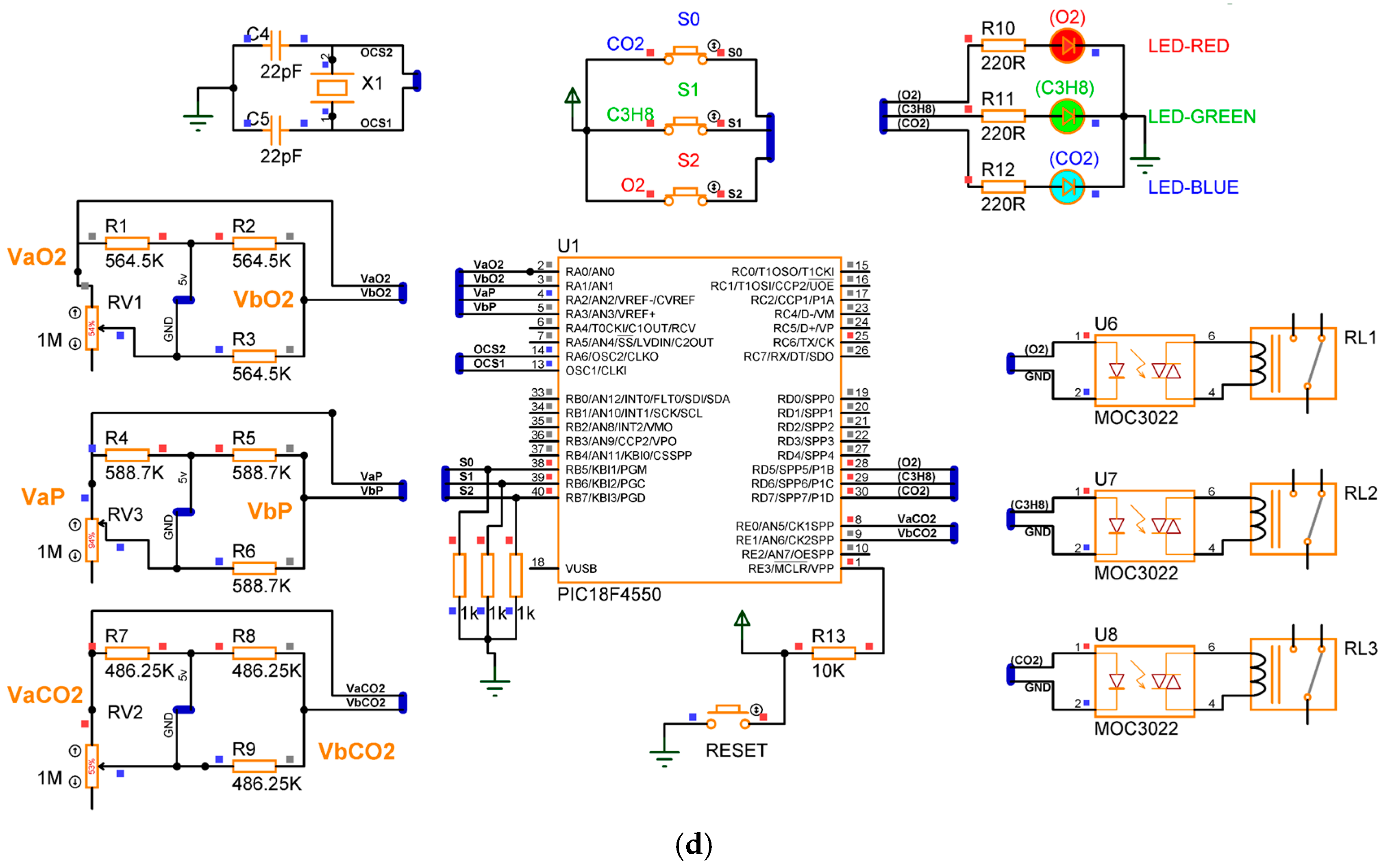

| Gas Detection Conditions | Corrective Signal Binary States | Indicator Diode Status Due to Gas Detection | ||||||
|---|---|---|---|---|---|---|---|---|
| Diode | ||||||||
| Red | Green | Blue | ||||||
| False | False | False | 0 | 0 | 0 | Off | Off | Off |
| False | False | True | 0 | 0 | 1 | Off | Off | On |
| False | True | False | 0 | 1 | 0 | Off | On | Off |
| False | True | True | 0 | 1 | 1 | Off | On | On |
| True | False | False | 1 | 0 | 0 | On | Off | Off |
| True | False | True | 1 | 0 | 1 | On | Off | On |
| True | True | False | 1 | 1 | 0 | On | On | Off |
| True | True | True | 1 | 0 | 1 | On | On | On |
| Switch State | Input Port State | Gas to Detect | ||||
|---|---|---|---|---|---|---|
| 0 | 0 | 0 | NAD | NAD | NAD | No gas detection |
| 0 | 0 | 1 | NAD | NAD | AD | |
| 0 | 1 | 0 | NAD | AD | NAD | |
| 0 | 1 | 1 | NAD | AD | AD | |
| 1 | 0 | 0 | AD | NAD | NAD | |
| 1 | 0 | 1 | AD | NAD | AD | |
| 1 | 1 | 0 | AD | AD | NAD | |
| 1 | 1 | 1 | AD | AD | AD | |
| Case | Input Variables | Output Variables | Gas to Detect | ||||
|---|---|---|---|---|---|---|---|
| 1 | 0 | 0 | 0 | 0 | 0 | 0 | No gas detection |
| 2 | 0 | 0 | 1 | 0 | 0 | 1 | |
| 3 | 0 | 1 | 0 | 0 | 1 | 0 | |
| 4 | 0 | 1 | 1 | 0 | 1 | 1 | |
| 5 | 1 | 0 | 0 | 1 | 0 | 0 | |
| 6 | 1 | 0 | 1 | 1 | 0 | 1 | |
| 7 | 1 | 1 | 0 | 1 | 1 | 0 | |
| 8 | 1 | 1 | 1 | 1 | 1 | 1 | |
| Quantity | Description |
|---|---|
| 1 | Transformer of 127 to 9 volts |
| 4 | 1N4007 Diodes |
| 1 | Electrolytic capacitor (330 µF) |
| 1 | Electrolytic capacitor (10 µF) |
| 1 | Electrolytic capacitor (1 µF) |
| 1 | 7805 voltage regulator |
| 1 | PIC18F4550 |
| 2 | Ceramic capacitors (33 pF) |
| 1 | Crystal of 20 MHz |
| 4 | Resistances of 220 Ω |
| 2 | Red LEDs |
| 1 | Greed LED |
| 1 | Blue LED |
| 3 | MOC3032 Optocouplers |
| 3 | Relays |
| 9 | Precision variables resistances (1 MΩ) |
| 3 | Illuminated switches |
| 2 | Perforated phenolic plate 14.6 × 7 cm |
Disclaimer/Publisher’s Note: The statements, opinions and data contained in all publications are solely those of the individual author(s) and contributor(s) and not of MDPI and/or the editor(s). MDPI and/or the editor(s) disclaim responsibility for any injury to people or property resulting from any ideas, methods, instructions or products referred to in the content. |
© 2025 by the authors. Licensee MDPI, Basel, Switzerland. This article is an open access article distributed under the terms and conditions of the Creative Commons Attribution (CC BY) license (https://creativecommons.org/licenses/by/4.0/).
Share and Cite
Guillen Bonilla, J.T.; Jiménez Rodríguez, M.; Bonilla, H.G.; Bonilla, A.G.; Padilla, E.H.; Morales, M.E.S.; Flores Jiménez, A.B.; Gutiérrez, J.C.E. The Design, Simulation, and Construction of an O2, C3H8, and CO2 Gas Detection System Based on the Electrical Response of MgSb2O6 Oxide. Technologies 2025, 13, 79. https://doi.org/10.3390/technologies13020079
Guillen Bonilla JT, Jiménez Rodríguez M, Bonilla HG, Bonilla AG, Padilla EH, Morales MES, Flores Jiménez AB, Gutiérrez JCE. The Design, Simulation, and Construction of an O2, C3H8, and CO2 Gas Detection System Based on the Electrical Response of MgSb2O6 Oxide. Technologies. 2025; 13(2):79. https://doi.org/10.3390/technologies13020079
Chicago/Turabian StyleGuillen Bonilla, José Trinidad, Maricela Jiménez Rodríguez, Héctor Guillen Bonilla, Alex Guillen Bonilla, Emilio Huízar Padilla, María Eugenia Sánchez Morales, Ariadna Berenice Flores Jiménez, and Juan Carlos Estrada Gutiérrez. 2025. "The Design, Simulation, and Construction of an O2, C3H8, and CO2 Gas Detection System Based on the Electrical Response of MgSb2O6 Oxide" Technologies 13, no. 2: 79. https://doi.org/10.3390/technologies13020079
APA StyleGuillen Bonilla, J. T., Jiménez Rodríguez, M., Bonilla, H. G., Bonilla, A. G., Padilla, E. H., Morales, M. E. S., Flores Jiménez, A. B., & Gutiérrez, J. C. E. (2025). The Design, Simulation, and Construction of an O2, C3H8, and CO2 Gas Detection System Based on the Electrical Response of MgSb2O6 Oxide. Technologies, 13(2), 79. https://doi.org/10.3390/technologies13020079






